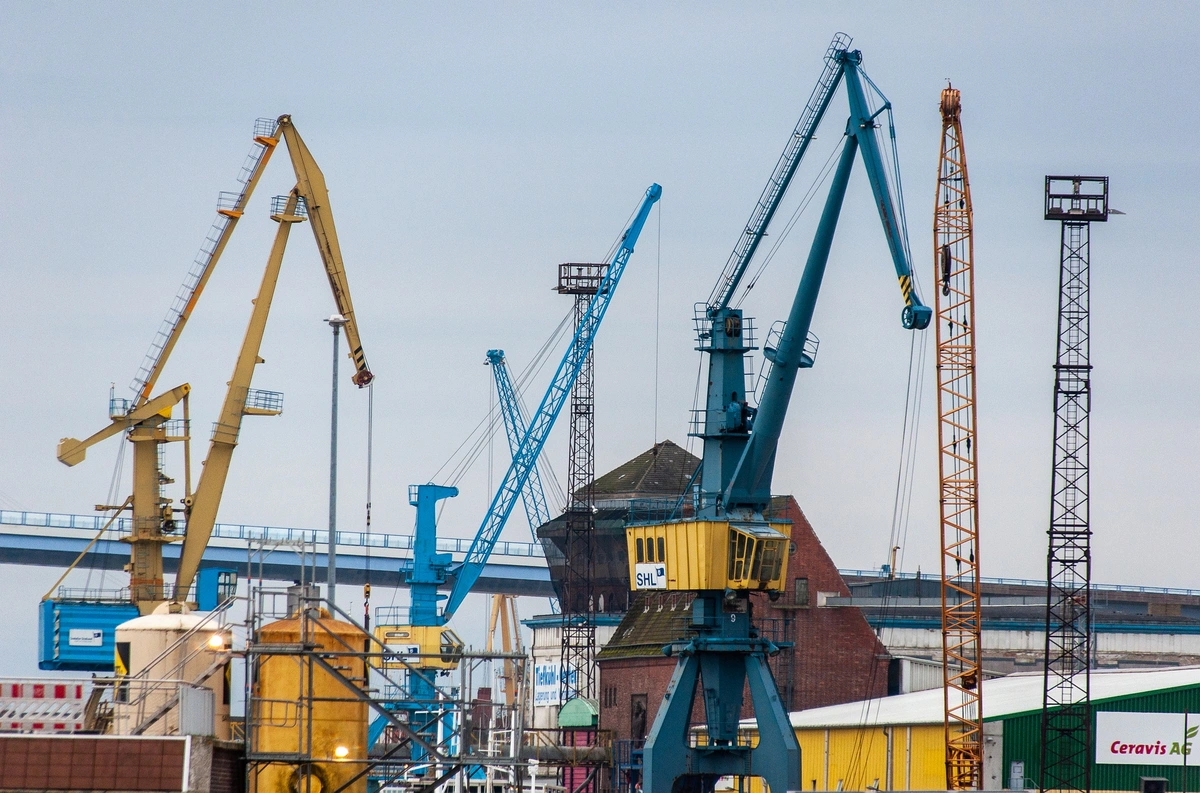9 Different Types of Cranes and Their Functions
9 Min read
)
September 10, 2023
Cranes are indispensable heavy machinery with diverse applications across industries, offering the capability to lift, transport, and precisely position hefty loads. This crucial machinery encompasses a broad spectrum of crane types, each meticulously engineered for distinct tasks. Proficiency in discerning the various crane varieties and comprehending their specific functions holds of greatest importance, as it guarantees the efficient and secure execution of construction and industrial projects. In this comprehensive guide to deck cranes, we start with an exploration of these machines, shedding light on their attributes and the vital roles they play in shaping modern engineering and industry.
What is a Crane
A crane is a mechanical marvel or aerial crane, comprising a hoist, wire ropes or chains, and sheaves. Its fundamental function revolves around the vertical lifting and lowering of substantial objects, coupled with horizontal mobility. Cranes hold a pivotal role across construction sites, warehouses, ports, and manufacturing facilities, contributing to the seamless movement of heavy loads. These versatile machines manifest in an array of sizes and configurations, granting them adaptability to multifarious applications. Their presence is transformative, facilitating tasks that would otherwise be formidable, underscoring their indispensable status in the realm of heavy machinery.
How Does a Crane Work
Cranes execute their formidable tasks by harnessing the principles of mechanical advantage, enabling them to effortlessly hoist hefty loads. Powered by either an electric motor or an internal combustion engine, the hoist system orchestrates the elevation and descent of the crane vessel its load. Concurrently, the crane's boom or jib extends and retracts, facilitating the horizontal movement of the deck crane. These intricate operations are meticulously orchestrated by skilled operators who utilize an array of controls, including levers, buttons, or remote devices, to ensure the precise and secure handling of loads. It is this masterful coordination of components and human expertise that underpins the safe and efficient functioning of cranes across various industries.
Choosing the Right Crane for Your Needs
The selection of the right crane is a pivotal decision in ensuring project success. It hinges on several critical factors, including the weight of the load, required reach, terrain conditions, and specific operational demands. Mobile cranes offer agility and adaptability, making them versatile options. Tower cranes shine in the construction of towering structures. Crawler cranes thrive in rugged terrains, while telescopic cranes extend to impressive heights. A profound understanding of your project's unique requirements is the compass guiding this choice, ultimately determining which crane will deliver maximum efficiency and safety, ensuring that your endeavor proceeds seamlessly and successfully.
Different Types of Cranes
:format(webp)) Cranes are engineering marvels that have transformed construction and heavy lifting across industries. In this exploration of various crane types, and their unique characteristics and applications, showcasing their pivotal role in modern engineering and construction.
Cranes are engineering marvels that have transformed construction and heavy lifting across industries. In this exploration of various crane types, and their unique characteristics and applications, showcasing their pivotal role in modern engineering and construction.
1. Tower Crane
Tower cranes are a ubiquitous sight on construction sites, often looming over the tall buildings already in progress. Renowned for their remarkable, lifting capacity, capacities, and extensive reach, they are the go-to choice for skyscraper construction projects. These cranes are engineered for stability and efficiency, thanks to their stationary design, which enables them to operate effectively within a predetermined radius. With their ability to handle heavy loads at great heights, tower cranes are indispensable in the construction industry, ensuring that towering structures can be erected safely and with precision.
2. Fixed Cranes
Fixed cranes are steadfast workhorses in industrial settings, renowned for their reliability in routine lifting tasks. These stationary machines are synonymous with stability, offering a dependable solution for consistent material handling. Commonly found in factories and warehouses, fixed cranes are designed to stay put, ensuring precision and efficiency in operations where loads need to be moved with regularity. Their robust, immovable design allows for the steady lifting and placement of materials, making them ideal for scenarios where a permanent lifting solution is required. In industrial environments, where precision and consistency are paramount, fixed cranes are valued assets for seamless material management.
3. Hammerhead Crane
Hammerhead cranes derive their name from their unique hammerhead-shaped design, setting them apart from overhead cranes in the world of construction machinery. These cranes are particularly advantageous in urban construction environments characterized by limited space constraints. Their compact configuration allows them to thrive where conventional aerial cranes might struggle. Hammerhead cranes excel in delivering precision during load placement, a critical factor in congested cityscapes where accuracy is paramount. Their ability to maneuver efficiently within tight quarters makes them indispensable assets on construction sites where space is at a premium, ensuring that building projects proceed smoothly and safely.
4. Mobile Crane
:format(webp))
Mobile cranes are renowned for their adaptability and versatility, boasting wheels or tracks that facilitate effortless mobility. Their versatility shines through in a wide range of applications, making them invaluable assets in diverse industries. From road construction projects requiring rapid equipment relocation to emergency recovery operations where agility is critical, mobile cranes prove their mettle. Their ability to swiftly navigate varied terrains ensures they can be deployed where needed, making them dependable workhorses in dynamic work environments. Whether it's lifting heavy loads at construction sites or responding to urgent recovery scenarios, mobile cranes stand ready to tackle the task at hand with efficiency and precision.
5. Crawler Crane
Crawler cranes are purpose-built for stability in rugged terrains and harsh conditions. Their distinctive tracks grant them outstanding mobility, making them the preferred choice for off-road and construction endeavors in challenging environments. These robust machines offer a reliable solution when the ground is uneven or unpredictable, thanks to their weight distribution capabilities and rugged tracks. Crawler cranes excel in scenarios where standard wheeled construction cranes often may falter, ensuring that construction projects proceed smoothly even in adverse conditions. Whether it's building infrastructure in remote areas or tackling demanding terrain, these cranes prove their worth by delivering stability and versatility in the most challenging settings.
6. Lattice Boom Crane
Lattice boom cranes are esteemed for their remarkable reach and exceptional load-carrying capabilities. These cranes are the go-to choice for heavy-duty applications, where robust lifting power is essential. Often found at bridge construction sites and bustling shipyards, lattice boom cranes are engineered to handle substantial loads with ease. Their lattice-like structure provides strength and stability in static cranes, allowing them to extend to great heights while maintaining precision in load handling. In demanding industrial settings, where the magnitude of loads is a challenge, lattice boom cranes prove invaluable, ensuring critical tasks like bridge and railroad crane assembly and shipbuilding progress efficiently and safely.
7. Telescopic Cranes
:format(webp))
Telescopic cranes are characterized by their telescoping booms, a feature that sets them apart from truck-mounted cranes in the world of heavy machinery. This innovative design of overhead cranes allows their booms to extend or retract as the situation demands, offering unparalleled adaptability across a spectrum of job requirements. This versatility makes telescopic cranes highly prized in diverse industries where flexibility is key. Whether it's construction, maintenance, or even disaster recovery operations, these cranes prove their worth by easily adjusting their reach to match the specific needs of the task at hand. Their capacity to swiftly adapt to changing circumstances makes them indispensable assets in various industrial settings.
8. Pickup Crane
Pickup cranes are compact, portable lifting solutions commonly mounted on trucks. These versatile machines excel in quick material handling tasks, finding their niche in smaller construction projects and providing valuable support in roadside assistance scenarios. Due to their mobility and ease of deployment, pickup cranes are indispensable when time is of the essence. They swiftly convert standard vehicles into capable lifting equipment, proving their worth in situations where larger hydraulic cranes alone would be impractical. Whether it's loading and unloading materials via a hydraulic crane on a construction site or aiding with vehicle recovery on the roadside, pickup cranes offer a convenient and efficient solution for various lifting needs.
9. Floating Crane
Floating cranes are specialized maritime equipment tailored for demanding marine operations. Their primary function is to hoist heavy loads onto or off of ships, making them indispensable in port and offshore construction projects. These robust machines are strategically designed to maintain stability on water while providing the lifting power required for transporting heavy cargo between vessels and docks. In the maritime industry, where precise and safe load handling is paramount, floating cranes play a vital role in ensuring the efficient transfer of goods and materials, contributing significantly to the success of port logistics and offshore installations. The telehandler forklift operator used a truck-mounted crane, rough terrain crane, carry deck crane, gantry crane, and construction crane to lift and move heavy objects on the construction site.
Conclusion
In conclusion, cranes play a vital role in modern construction and other industries. Understanding their types and functions is crucial for safe and efficient operations. By selecting the right type of crane for your specific needs, you can ensure the successful completion of projects while prioritizing safety and productivity. Whether it's a towering structure or a heavy load of water, there's a crane designed for every job. Always consult with experts and adhere to safety guidelines when working with cranes to minimize risks and maximize productivity.

Caleb Woods is an experienced content specialist and an editor at Boom & Bucket, blending his journalism background with expertise in the heavy equipment industry. He delivers engaging, informative content to help professionals stay informed and make smarter decisions in the machinery market.














